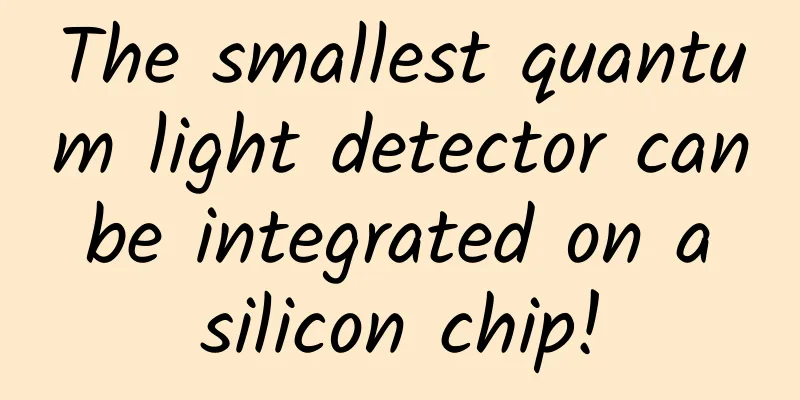The smallest quantum light detector can be integrated on a silicon chip!

|
The smallest quantum light detector on a silicon chip was developed by researchers at the University of Bristol in the UK. This is a quantum light detector integrated on a silicon chip, which is even smaller than a human hair. The research results were published in the journal Science Advances on May 19, 2024. This quantum light detector, called a homodyne detector, can operate at room temperature and is suitable for quantum communications, extremely sensitive sensors such as state-of-the-art gravitational wave detectors, and certain quantum computers. Its integration marks an important step forward in the miniaturization and mass production of quantum devices. The key to this technology is that it uses mature, commercially available manufacturing technology, which helps to apply it to other technologies such as sensing and communication at an early stage. The researchers said that this detector can be very fast, which is crucial for high-speed quantum communication and realizing the high-speed operation of optical quantum computers. In addition, the detector is not only small and fast, but also highly sensitive, allowing it to measure quantum states very precisely. The researchers plan to further improve the efficiency of the new detector and test it in many different applications. This research brings new possibilities for the development of quantum technology, especially in the fields of quantum computing and quantum communication, and is expected to push quantum technology into a new stage of development. Image source: University of Bristol official website Silicon-based quantum light detectors have some obvious advantages over traditional photodetectors. First of all, the working principle of silicon-based quantum light detectors is based on the photoelectric effect of silicon materials, which has high sensitivity in silicon materials. This means that silicon-based quantum light detectors can produce large current changes under very small light intensity, thereby improving the sensitivity of the detector. Secondly, silicon-based quantum light detectors use advanced microelectronics technology, which gives them a great advantage in production costs. In addition, silicon-based quantum light detectors can also be monolithically integrated with other microelectronic devices, which helps improve product reliability and consistency. Furthermore, silicon-based quantum light detectors also have certain advantages in performance. For example, silicon-based quantum light detectors can achieve higher response speeds and higher quantum efficiency, which is very important for certain demanding detection applications. Finally, silicon-based quantum light detectors also have certain advantages in application fields. Due to the characteristics of high sensitivity, low cost, high response speed and high quantum efficiency, silicon-based quantum light detectors have broad application prospects in aerospace, security inspection, medical treatment, intelligent control and other fields. Silicon-based quantum photodetectors have shown certain advantages in sensitivity, cost, performance and application areas, which makes them have great potential in the future photoelectric detection market. Silicon-based quantum photodetectors face multiple challenges in research and application. First, in order to process a large number of single photons, a fast, low-loss optical switching network is required, and the technical needs in this regard have not been fully met. Secondly, it is a huge challenge to achieve the full integration of quantum light sources, circuits, and detectors on silicon-based photonic chips, especially the need to solve the problems of pump light removal and low-temperature manipulation of photons. In addition, there are many problems in the design and manufacturing process of silicon-based photonic chips, such as the lack of compact models, the lack of standard link models, and the lack of necessary verification methods, which lead to inefficient design processes. In response to the above challenges, the future improvement directions of silicon-based quantum light detectors mainly include the following aspects: Improving the performance of optical switching networks: Research and develop more efficient and lower-loss optical switching technologies to support large-scale quantum information processing. Improve integration technology: Explore new technologies for integrating quantum light sources, circuits, and detectors on silicon-based photonic chips, such as silicon-based switching technology that can operate at low temperatures. Optimize design process: Improve the design process of silicon-based photonic chips, including device simulation, system simulation, layout design, and preparation testing, to improve design efficiency and referenceability. Improving Materials and Manufacturing Processes: Research and develop new materials and manufacturing processes to improve the performance and reliability of silicon-based quantum light detectors. Strengthen the construction of the industrial chain: Establish a complete silicon-based optoelectronics industrial chain, including multiple integration solutions such as front-end integration, back-end integration and hybrid integration, to achieve mass production of high-performance products. Silicon-based quantum photodetectors will continue to improve in performance, integration technology, and design process optimization in the future to meet the growing needs of quantum information processing. References: 1. The smallest quantum light detector can be integrated on a silicon chip - China Science and Technology Network 2. Micro quantum light detector: opening a new door to high-speed quantum communication - Byte Click 3. New breakthrough in quantum technology integrates miniature quantum light detectors on silicon chips - NetEase 4. Researchers integrate the world's smallest quantum light detector on a silicon chip 5. The smallest quantum light detector can be integrated on a silicon chip - NetEase 6 Development of silicon-based single-photon detectors based on optical waveguide integration - Baidu Encyclopedia 7. The smallest quantum light detector can be integrated on a silicon chip, opening up a new era of quantum technology - China.com |
>>: There are so many pots, how do you choose a good and suitable one?
Recommend
Uncovering the Violent Pornography on WeChat
“You can never cheat the Chinese out of their mon...
Afraid of allergies and afraid to appreciate flowers? These "invisible" flowers are the culprit!
The peak season for pollen allergies is here agai...
Chengdu will have rainfall for 36 days in the next 40 days? You may not even check the weather forecast...
Yesterday Topic #Chengdu will have rainfall for 3...
Douyin operation strategy for the food industry
1. Food Industry Development Background 1. Accord...
How to seize the traffic of Xiaohongshu platform?
In today's world where consumer groups and co...
Starting as a "temporary worker", how did Airlock transform into a "business elite"?
Currently, Chinese astronauts are using the Wenti...
Comparing the two years of Stanford AI reports: 32 charts to help you fully understand the development of the industry
The AI Index project of Stanford University'...
How does this content sharing community achieve user growth?
Using Jianshu V2.11.2, draw the product structure...
Naked shopping has triggered a new shopping trend. Is the “unpackaged” shopping method reliable?
The piles of paper boxes, tapes, and fillers afte...
Bidding promotion actually has guiding significance for SEO
Feng Chao from Dongguan has always believed that ...
How terrible would it be to have a major earthquake that caused the fall of an empire?
When you find that the sea water at the beach has...
Android March security update will fully fix MediaTek-SU permission vulnerability
Google today reiterated the importance of keeping...
How much does it cost to customize the Linyi wine and beverage mini program? Linyi wine and beverage applet customized price inquiry
There are two types of customization of Linyi Liq...
White is not the base color of the earth!
As my country's urbanization and modernizatio...









